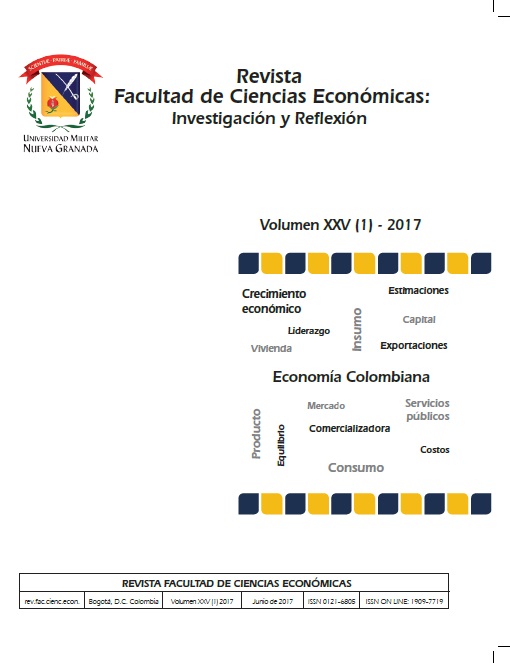Colombian exports do they evolve towards a more volatile market?: an analysis of the period 1974-2014
Abstract
This study seeks to determine whether the Colombian economy moves toward a more unstable export structure, for which analyzes both; the evolution of the economy between 1974 and 2014, price volatility; understood as deviations around the mean, corrected or not by the trend and without trying to explain the reasons for the instability. The results show that Colombian exports follow a marked tendency to move minerals and energy products, rather than agricultural. Commodity prices generally tend to grow, reaching their peak in the first decade of the XXI century. Considered Volatility Indicators applied to traditional export products´ price indexes and other combined price indexes suggest greater volatility in the markets to which Colombia exports move: minerals. With regard to the trend following the volatility in the prices considered, the results are inconclusive. While the basic indicators point to a growing fluctuation in agricultural prices, the range of Parkinson suggests otherwise.Downloads
References
Álvarez, M. & Bermúdez, M. (2012). Evolución del comercio exterior de Colombia desde la óptica de los acuerdos comerciales. Ministerio de comercio, industria y turismo de la República de Colombia, documentos OEE-12.
ANIF (2016). Situación macro-financiera y fiscal de Colombia. En: Colombia: Desarrollo empresarial y costos económicos de la paz. Seminario Macroeconómico y Feria de Servicios Empresariales, Bucaramanga.
Banco de la República (2014). Evolución de la balanza de pagos 2013. Bogotá.
Balcombe, K. (2009). The nature and determinants of volatility in agricultural prices: an empirical study from 1962-2008. In: The evolving structure of world agricultural trade (Sarris A., Morrison J., eds), FAO, Italy, 109-136.
Bonifaz, J. & Mortimore, M. (1999). Colombia: un CANalísis de su competitividad internacional. CEPAL, Serie Desarrollo Productivo 58.
CEPAL-FAO-IICA (2011). Volatilidad de precios en los mercados agrícolas (2000-2010). Implicaciones para América Latina y opciones de políticas. Perspectivas de la agricultura y del desarrollo rural en las Américas: Una mirada hacia América Latina y el Caribe. Boletín 1.
Echevarría, J. (1987). La evaluación de las exportaciones colombianas y sus determinantes. Un análisis empírico. Ensayos sobre política económica, 2: 257-294.
Garay, L. (2004). Colombia: Estructura industrial e internacionalización 1967-1996. Biblioteca virtual del Banco de la República.
Gilbert, C. (2003). Trends and volatility in agricultural commodity prices. Ponencia presentada en State of Research and Future Directions in Agriculture Commodity Markets and Trade, FAO. Roma.
Gilbert, C. & Morgan, C. (2010). Has food price volatility risen? Universitá degli Studi di Trento, Italia. Discussion paper 2/2010.
Huchet-Bourdon, M. (2011). Agricultural Commodity Price Volatility. OECD Food, Agriculture and Fisheries Papers, 52. OECD publishing. doi: http://dx.doi.org/10.1787/5kg0t00nrthc-en
Jacks, D., O'Rourke, K. & Williamson, J. (2009). Commodity price volatility and world market integration since 1700. NBER Working paper series 14748. https://doi.org/10.3386/w14748
Jacks, D. S. (2013). From boom to bust: A typology of real commodity prices in the long run. NBER Working paper series 18874. https://doi.org/10.3386/w18874
Labys, W. (2006). Modeling and forecasting primery commodity prices. Ashgate publishing Ltd, 239pp.
Mesa, R., Gallón, S. & Gómez, K. (2001). Entorno y evolución de las exportaciones colombianas en la década de los noventa. Lecturas de Economía, 55: 163-180.
Parkinson, M. (1980). The extreme value method for estimating the variance of the rate of return. Journal of Business, 53: 61-65. https://doi.org/10.1086/296071
Sumner, D. (2009). Recent commodity price movements in historical perspective. American Journal of Agricultural Economics, 91 (5): 1250-1256. https://doi.org/10.1111/j.1467-8276.2009.01292.x











